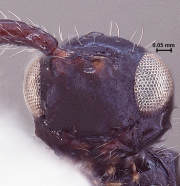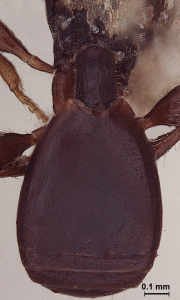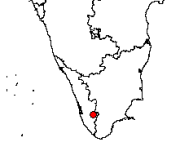 Fig 1. Female, profile |
 Fig 2. Head, dorsal view |
 Fig 3. Head, front view |
 Fig 4. Antenna (female) |
 Fig 5. Forewing |
|
 Fig 6. Mesosoma |
 Fig 7. Metasoma |
 Fig 8. Distribution map |
|
Nomenclature
Nigropria Rajmohana & Narendran, 2000: 193-200. Type species Nigropria compressa Rajmohana & Narendran.
Diagnosis
2mm long, with robust body. Head and body black, with appendages much lighter in colour, with a smooth and shining body, lacking micropilosity, with sparse long semierect hairs, never with foam-like structures, pilosity sparse on post gena, sides of pronotum and upper part of propleuron.
Head subglobose dorsally. Antennal shelf often well developed. In lateral view vertex angulate. Ocelli placed high on vertex. Eyes not as long as malar space, bordered dorsally by a longitudinal adorbital carina, originating from a level, lower to lateral ocelli, near to orbital margin, encircling eyes and reaching post gena. Ommatidia distinct. Malar sulcus distinct, mandibles, normal, not beak-like, bidentate. Occipital flange weakly indicated. Antennae 13-segmented in females, without distinct clava, segments gradually enlarged towards tip distally and with scattered fine pubescence, nearly as long as width of A2. A13 distinctly longer and larger than A12.
Cervix distinct. Pronotal shoulders sharply angulate. Mesoscutum dorsoventrally compressed and not convex dorsally, with notauli deep, distinct and greatly diverging laterally. Humeral and suprahumeral sulcus lacking. Anterior scutellar pit bifoveate. Lateral and posterior scutellar pits absent. Scutellar sheath rather wide and with a horizontal row of pits, near to posterior border. Sternaulus present. Dorsellum with three keels medially. Propodeum elongate, sparsely hairy. Median keel weakly raised anteriorly. Area between median keel and lateral ones (plicae) almost bare. With irregular longitudinal carinae and reticulate sculpture laterally. Metapleuron with dense sculpture. Nucha indicated in some cases.
Wings fully developed. Venation reaching nearly up to half of forewing length. Costal cell relatively broad. Marginal vein short, postmarginal absent and stigmal vein distinct. Basal vein nebulous and slightly arcuate. Marginal cilia of forewings very much reduced, nearly one-eighth of forewing width.
Petiole robust, longer than wide, narrower at base than at apex, mostly smooth, longitudinal striae inconspicuous. Metasoma dorsoventrally compressed, elongate, with anterior margin of T2/ large tergite not elevated above level of petiole and with distinct concavity or notch medially. Basal tergites telescoped under large tergite.
Geographic Distribution
See distribution map (Fig.8).
Species known from India
1. Nigropria compressa Rajmohana & Narendran
Remarks
A monotypic genus. Male unknown. Members of this genus can be diagnosed by their robust and dorsoventrally depressed and flattened body, raised antennal shelf, normal mandibles, 13-segmented antennae lacking an abrupt clava, distinct notauli, anterior scutellum with two pits, forewings large and wide, with reduced marginal cilia and anterior margin of T2 concave.
The genus differs from Spilomicrus Westwood in A13 being longer than A12 and in the presence of a concavity or notch on anterior margin of T2.
References
|